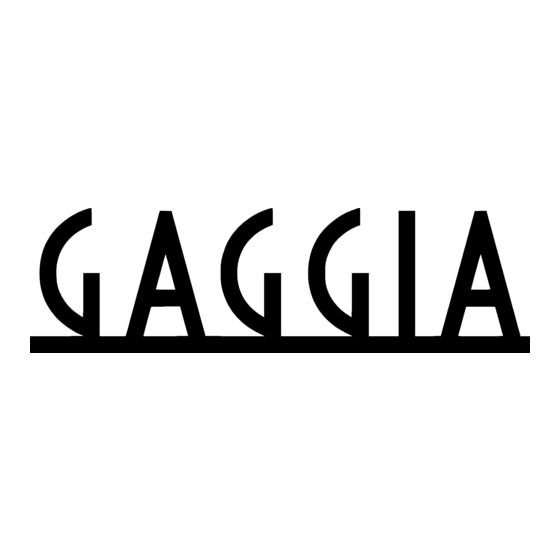
Advertisement
Quick Links
CARE SHEET
Like a car, your espresso machine is an investment whose performance and longevity depend on proper care and
operation. To help ensure that you get the most out of your machine, we have outlined several key maintenance
procedures that will help to keep it brewing and steaming properly. The following information applies to most of
our Semi-Automatic espresso machines, unless indicated otherwise.
Group Head Cleaning:
Tools Required:
•
Flat-Head Screwdriver
•
Phillips Head Screwdriver
•
Needle Nose Pliers
•
A Stiff-Bristled Brush
•
Gaggia Decalcifying Solution
1. Remove the water tank, drip tray and grid, portafilter, and power cord.
2. Lay the machine on its back.
3. Locate the shower screen. It is where you lock the portafilter into place.
4. Remove the shower screen, it is fastened into the group head with a Phillips head screw in the center. Once the
screen is out, the 3/4 inch-thick aluminum shower holding plate is exposed. It is held in place by two 5mm Allen
bolts.
5. The shower holding plate should just drop out after you remove the Allen screws. If it does not, use a large
flat-blade screwdriver to gently pry out the shower holding plate. Be careful not to damage the ridge that the
shower screen fits up into. If you do, a new holding plate is available.
Sometimes, the shower holding plate may really be stuck. To remove a plate that is stuck, you can use a pair of
needle-nose pliers. Open the pliers and stick the points into the holes where the Allen bolts were, then turn hard.
This should free the shower holding plate. Clean out any build-up that you see using a stiff brush and some
descaling solution – the same kind you would use to descale the machine.
6. You should now be able to remove the group gasket. It is a large black rubber ring.
7. Once the parts are removed, use a stiff brush and some descaler, like Gaggia Decalcifier, to clean any build up in
the group head. You can also soak all metal parts in the descaler to remove tough stains and build up. DO NOT
soak any plastic pieces in the descaler, as it can compromise their integrity. This is also a good time to soak the
portfilter head and coffee baskets.
8. Once everything is clean, make sure you thoroughly rinse off any descaler or other detergent that you used dur-
ing the cleaning process.
9. Reassemble the group head and test to make sure it has been put back together correctly.
Advertisement

Summary of Contents for Gaggia semi automatic
- Page 1 6. You should now be able to remove the group gasket. It is a large black rubber ring. 7. Once the parts are removed, use a stiff brush and some descaler, like Gaggia Decalcifier, to clean any build up in the group head.
- Page 2 CARE SHEET PAGE 2 Group Gasket Replacement: The group gasket is a rubber gasket that rests inside of the group head of a semi-automatic espresso machine and creates a seal to prevent leaks. Over time, the gasket becomes worn through use, which can lead to leaking during the brewing process.
- Page 3 CARE SHEET PAGE 3 2. When all of these parts have been removed, lay the machine down on its back.
- Page 4 CARE SHEET PAGE 4 3. Before removing the group gasket, the shower screen and the shower holding plate must be removed before- hand. The shower screen is held in place by a number 2 Phillips-head screw, and the plate behind it by a set of 5mm Allen screws.
- Page 5 CARE SHEET PAGE 5 4. If the shower screen plate does not fall out of the machine once the Allen screws have been removed, it may need to be gently pried out. A flat-head screwdriver or knife works well for this purpose. If the plate still will not come out, a pair of needle nose pliers can be inserted into the holes for the Allen screws and turned until the plate comes loose.
- Page 6 CARE SHEET PAGE 6 6. When the screw is secure, grasp it (with pliers if necessary) and pull until the gasket comes out. 7. After the gasket has been removed, make sure the surface inside of the group head is free of any debris or any- thing else that could block the new gasket.
- Page 7 CARE SHEET PAGE 7 Gaggia Pannarello Wands are made out of five components. The cap nut, the inner wand, a small plastic gasket, a large rubber gasket, and the frothing sleeve. The following steps outline how to remove a Pannarello wand.
- Page 8 CARE SHEET PAGE 7 2. To remove the inner wand, grasp it between your thumb and forefinger and with your opposite hand, unscrew the cap nut which holds it in place. 3. When the nut has been fully unscrewed, you will be able to slide the inner wand off of the steam arm, when you do, take care not to lose the small plastic gasket located between the inner wand and the cap nut.
- Page 9 8. There may be some slight variation in the designs of the wands that come with each machine, but the process outlined above applies to all varieties of Pannarello Wands currently offered by Gaggia.
- Page 10 Another small container to catch water from the group head 1. Remove the machine’s water reservoir and empty all of the liquid from it. 2. Mix or dilute your Gaggia Decalcifier according to the directions in a separate container. 3. Fill the reservoir with the solution.








